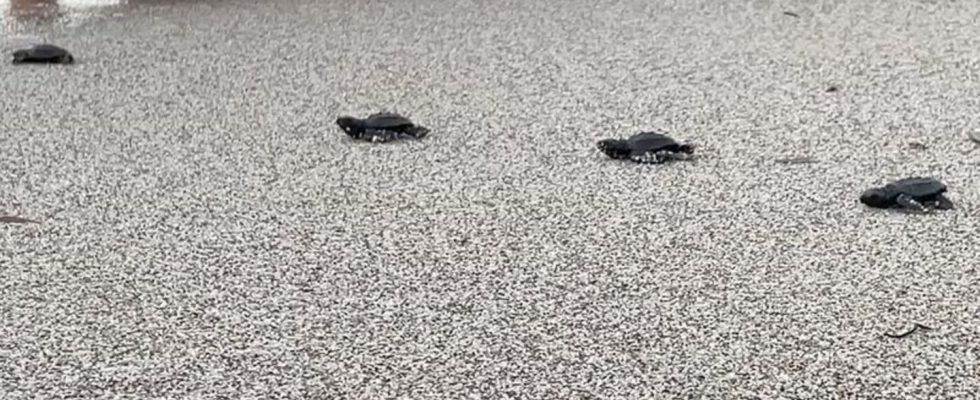Last year, an unusually large number of sea turtles nested in the western Mediterranean. This could be related to climate change. But higher temperatures pose dangers for the animals.
Baby black turtles crawl slowly and somewhat laboriously towards the sea on the beach at Capo di Feno in southern Corsica. Onlookers stand around, marvel at and film the spectacle. The birth of around 70 small loggerhead sea turtles (Caretta caretta) on the French island in autumn was quite unusual. While sea turtles otherwise hatch from their eggs year after year in the eastern Mediterranean on beaches in Turkey, Greece and Cyprus, they are rarely seen this far west.
Last year was a record year, with 444 nests on the Mediterranean coasts of Spain, France and Italy, according to the Life Turlenest project. Is climate change behind it?
The Mediterranean was particularly warm last year
Loggerhead sea turtles are highly dependent on water temperature. Like other species, they have a kind of comfort zone, explains Judith Denkinger from the Oceaneum in Stralsund. It shouldn’t be too warm and not too cold. “It is simply a fact that the Mediterranean has warmed in recent decades,” says the expert on marine mammals and turtles. The past year was extreme. There was a heat wave in the Atlantic, which has an enormous influence on the Mediterranean. “I think the Mediterranean was even five degrees above normal. That’s quite intense in such a large body of water.”
The loggerhead sea turtle’s main distribution area is actually in the eastern Mediterranean, says the marine biologist. “But if things have gotten too warm there because the sea has warmed up too much and the sunlight is also too warm, then these habitats will become unsuitable for sea turtles and they could then go somewhere else.” Also because the higher temperatures meant that algae were missing as nutrients in the water. But all of these are long-term processes. There hasn’t been much research on this so far.
The many nests could also be a bad sign
“You shouldn’t jump to conclusions,” says Cathy Cesarini, who heads the organization for the protection of whales and turtles CARI in Corsica, about the unusually high number of nesting sites in the western Mediterranean last year. “It is possible that it is a search for new areas.” But there are different hypotheses. “We will have to see whether this is just this one year or whether this is something that repeats itself.” It would be exciting to see whether there were fewer turtle nests in the Eastern Mediterranean. But the animal rights activist believes this is practically impossible. “There’s so much nesting there that if there are 480 fewer nests there, they won’t even notice.”
A possible explanation for the many nests in Corsica could also be that females often returned to their place of birth to lay eggs. Already in the last century, people in Corsica claimed to have seen turtle eggs, says Cesarini. But there is no evidence for this. Marine biologist Denkinger speaks of the high habitat fidelity of the animals, which nested on the same beach again and again. “That’s a bit of a problem because they wouldn’t be able to move out in time,” for example if it got too hot.
Heat can become a huge problem for animals
Because heat is by no means a welcome enabler for sea turtles to open up more places for nesting. In fact, it could become an immense problem for the animals. Because warm water expands more than cold water, rising sea temperatures are accompanied by rising sea levels. Nesting sites could be flooded and lost, explains Denkinger. When it gets extremely hot, the eggs in the nests become more heated and fetuses die.
Heat can also be fatal for turtles, as not only the chromosomes, but also the temperature in the egg determines the sex. There are more females in warmer parts of the nest and more males in colder places. Denkinger warns: Temperatures that are too high could lead to an excess of females. “In the Caribbean you can clearly see that there are fewer and fewer males on the road, or even disappear altogether.” Older males could step in for a while because the animals are so long-lived, says the researcher. “But if this continues, then their extinction is inevitable.”
Marine biologist: need to reduce emissions
How the animals can be protected from high temperatures is clear to the marine biologist: “The only thing we can do is reduce emissions.” In general, less plastic should also be used. This is a problem for the animals, for example when they die from plastic bags in their throats or when they find it harder to dive due to undigested plastic in their stomachs. According to Denkinger, more natural beaches and the protection of habitats are also important. Before and during the mating season, no speedboat traffic should be allowed near the beach where males and females frolic.
A boat ban would probably not be necessary at Capo di Feno in Corsica. Charlène Thevenet, who protected the nest in Capo di Feno as a volunteer, says that the beach was quite quiet. There is currently no tourism related to sea turtles in Corsica. In total, only five nests were found on the island. “I’m afraid that when there are births again next year, there will be a lot of tourists coming.” If there are more nests, a lot of educational and awareness work needs to be done.
But it remains to be seen whether the many births of sea turtles in the western Mediterranean last autumn remain an exception or whether the animals will now regularly build nests in Corsica.
Post Life Turtlenest about nesting sites in the Western Mediterranean Information about Life Turtlenest

